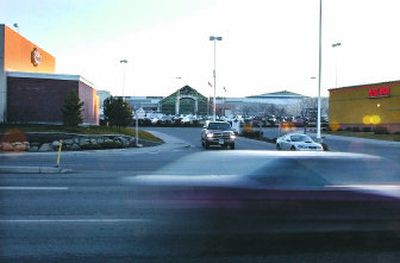EXPANSION ON THE EDGE

From the new gas pumps at the Sullivan Road Fred Meyer, to the curbside Walgreen’s in Millwood’s Argonne Plaza parking lot, smaller stores are growing like dandelions in big retail’s vast parking lots.
And that might not be a bad thing in the eyes of urban planners trying to cap urban sprawl. Pad development, as it’s known, involves cutting new business lots into the blacktop outside shopping centers and big box retail, which clusters businesses on a single site and can partly cut down on driving.
The concept has been around for a while. Spokane Valley Mall was built with curbside restaurants in mind. But now stand alone grocery stores and fitness centers are getting into the act.
“One of the things about retail is you need critical mass,” said Marina Sukup, Spokane Valley community development director. “The more things you have to choose from the better off you are.”
Urban designers would like to see development taken a step further with customers encouraged to walk rather than drive, and to live near where they shop. But pads are erasing some of the black in Spokane Valley’s retail areas.
By summer, John Hillier expects Albertsons Food and Drug Store will have some commercial company at 32nd Avenue and Highway 27. After years occupying the corner by itself, Albertson’s negotiated the sale of the property on its outer edges. The ink isn’t quite dry on the deal, said Hillier, a commercial leasing manager for Goodale and Barbieri, a real estate development and property management firm. Plans are under way for pads featuring a bank and maybe five shops.
Housing development slated for the area around the store and a consumer desire to shop closer to home in fewer trips is behind the transformation.
“That building has been there for a number of years as kind of a stand alone,” Hillier said. “As the neighborhood has grown, the people (moving in) there expect to go to a Starbucks in their area.”
What Albertson’s expects is some synergy, a give and take of customers between itself and the yet to be named new guys on the corner. There are other factors at play at 32nd and Highway 27 that give the grocery retail advantage. A cemetery is being constructed on the southwest corner of the intersection. Kitty-corner from the grocery is a retail strip too small for a rival big box. The northeast corner of the intersection isn’t suitable for development.
Experts say pad development can do a lot for a large store like Albertson’s. Shopping centers and big box stores can literally be more than a football field’s distance from consumers driving by. On a busy day, sea of asphalt between a store and a curb can fill with cars and make a shopping center look like the place to be. On a slow day, that empty blacktop can make business look dead.
“Normally you see a big box store on a large site and they put the big box on the back end and leave the front open, the general thought is that when the market is right they can put pads on the front end,” said Sukup. “The person who subdivided the 24 Hour Fitness location, I think it’s Oz Fitness now, divided it up with parcels on the street.”
Then there are the parcels that aren’t divided at the time an anchor store opens. At the corner of Sprague Avenue and Blake Road, developers are trying to cut up the property occupied by ShopKo. Owned by Tombari and Grant, the property has a typical big-box layout with the building in the back and a couple hundred feet of asphalt between it and the street. Much of the parking lot doesn’t get used. There’s a store-sized, unpaved portion of the property right at the corner of Blake and Sprague could be a hot place for a business. Instead it’s a reluctant host for people looking for a visible place to sell their personal vehicles.
What the lot owners are trying to do is cut the property into five different lots through an application process known as a site binding plan. The process doesn’t put a pad in ShopKo’s parking lot tomorrow. It does lay the brickwork for the parcel to not only be leased, but sold, should a buyer come along.
“There are just those entities that want to own their dirt,” said Todd Whipple, a consultant shepherding the parcel division through the local government process. “As it now sits, everything has to be leased.”
Managed growth proponents see the potential for binding site plans, like the one Whipple’s now working on, to be a tool for progressive land use change, a chance to add townhouses to a property or first-floor retail and second-floor apartments, maybe make the site more multifunctional.
“The issue we have with it is what do the county or city regulations provide for?” said Tim Trohimovich, planning director for the Washington smart-growth group Futurewise. “We encourage people to make developments walk-able, bike-able and really to encourage multiple use.”
Strip malls across the state are trying to redevelop themselves right now, Trohimovich said. Adding retail spots along the street can be part of that process, but to the extent those changes feed into a car culture and discourage walking, they don’t go far enough.